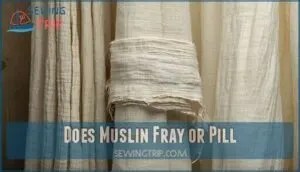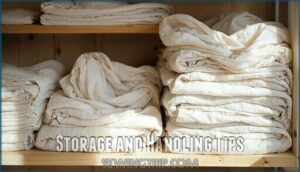This site is supported by our readers. We may earn a commission, at no cost to you, if you purchase through links.

You’ll notice small thread balls (pilling) forming on the surface and loose threads unraveling at cut edges (fraying). This happens naturally with regular use and washing since muslin’s open weave structure makes fibers more prone to breaking free.
However, you can substantially reduce both issues through proper handling techniques. Using pinking shears for cutting, finishing raw edges, and washing gently in cool water helps maintain your muslin’s integrity.
The good news? Smart prevention methods can keep your muslin looking fresh much longer than you’d expect.
Table Of Contents
Key Takeaways
- You’ll notice both fraying and pilling with muslin since its loose plain weave construction makes fibers prone to breaking free and tangling together on the surface.
- You can prevent most fraying by using pinking shears for cutting, finishing raw edges with serging or hemming, and choosing tighter-weave muslin varieties over looser ones.
- You’ll extend your muslin’s lifespan by washing it gently in cold water with mild detergent and air-drying instead of using machine heat that damages cotton fibers.
- You should match muslin weight to your project needs—lightweight for crafts, medium-weight for clothing prototypes, and heavy muslin for upholstery or high-wear items that resist fraying better.
Muslin Fabric Properties
You’ll find muslin’s unique properties make it both versatile and challenging to work with.
This lightweight cotton fabric features a plain weave structure that creates excellent breathability but also makes it prone to fraying and pilling with regular use, which can be considered its unique properties.
Breathability and Softness
Muslin’s plain weave creates an airy feel that makes this lightweight fabric incredibly breathable.
You’ll notice its natural softness comparison to other cottons immediately upon touch.
The loose weave structure provides comfortable wear for clothing and bedding applications.
This breathable fabric works perfectly for summer garments, baby items, and craft projects where air circulation matters most, making it ideal for applications requiring breathable fabric.
Durability and Strength
Despite its lightweight construction, muslin offers surprising durability when you choose quality materials.
Weave tightness directly impacts muslin fabric strength – tighter weaves resist fraying and provide better muslin durability than loose constructions.
Fiber quality determines your muslin lifespan, with premium cotton lasting longer through repeated use.
Reinforcement methods like proper hemming extend fabric life substantially, making muslin suitable for its intended use, and providing better durability.
Thread Count and Weave
Thread count in muslin fabric directly affects its fraying and pilling tendencies. Lower thread counts create looser weaves that unravel more easily.
Here’s what you’ll notice:
- Weave tightness determines how securely fibers lock together
- Thread quality affects overall fabric weight and durability
- Fiber density influences muslin pilling resistance substantially
- Muslin types vary from loose gauze to tight sheeting weaves
Understanding muslin weave type helps predict muslin fabric fraying behavior. The plain weave is durable, making it a common choice.
Does Muslin Fray or Pill
Your muslin’s loose weave structure creates perfect conditions for both fraying and pilling.
That loose weave? It’s basically an open invitation for fraying and those pesky fabric pills.
When you cut muslin fabric, the loosely woven cotton fibers naturally unravel at raw edges, creating visible loose threads. This fraying increases with frequent use and washing as broken fibers become more exposed.
Pilling occurs when cotton fibers break and tangle together, forming small balls on the fabric surface. Muslin’s lower thread count and softer fibers make it particularly susceptible to this issue.
You’ll notice pilling after just a few washes or uses since natural muslin doesn’t receive anti-pilling treatments.
The weave impact varies substantially between muslin types. Lighter, loosely woven varieties fray and pill more than heavier, tightly woven options.
Fiber quality also matters – premium muslins with better construction resist breakdown longer than economical versions. Understanding these characteristics helps you choose appropriate muslin for your project and set realistic expectations for long-term care.
Muslin is a breathable, natural fabric, but its properties also contribute to these wear characteristics.
Preventing Fraying and Pilling
You can prevent muslin from fraying and pilling with the right cutting tools and care methods. These simple techniques will keep your fabric looking fresh and extend its lifespan substantially.
Using Pinking Shears
One simple tool transforms your muslin cutting experience—pinking shears create zigzag edges that naturally resist fraying.
These specialized scissors make cutting techniques more effective for muslin sewing tips.
Here’s your essential pinking shear guide:
- Choose quality shears – Sharp blades guarantee clean angle cuts that prevent muslin fraying
- Match blade size to fabric – Smaller teeth work better for lightweight muslin fabric compatibility
- Keep blades sharp – Regular shear maintenance prevents ragged cuts that worsen fraying
- Cut in one motion – Smooth, continuous cuts create the best muslin fraying prevention
- Store properly – Clean, dry storage maintains cutting precision for muslin fraying solutions
Consider purchasing different brands for superior performance.
Edge Finishing Techniques
Beyond pinking shears, proper edge finishing techniques provide stronger protection against muslin fraying.
Serging edges with an overlock stitch creates the most durable finish, binding raw edges with multiple threads.
French seams work well for lightweight muslin, encasing edges completely.
Zigzag stitching offers a quick home solution, while bias tape and hemming muslin provide professional results for preventing muslin fraying.
For mid-weight fabrics, a simple zig-zag finish can also be effective, using techniques like overlock stitch and French seams to achieve a strong finish.
Gentle Washing and Drying
When caring for your muslin fabric care, cold water protects delicate fibers from damage.
Use mild detergent with gentle cycles to prevent excessive stress. Avoiding agitation helps stop muslin fraying during wash cycles.
Air drying preserves fabric integrity better than machine heat. These muslin washing tips prevent both fraying and pilling, keeping your fabric looking fresh longer.
To further protect the fabric, consider using pH-neutral detergents to ensure the longevity of your muslin fabric, and always handle it with gentle care and delicate handling.
Choosing Right Muslin Fabric
You’ll find success by matching your muslin choice to your specific project requirements and understanding the different fabric weights available.
Consider factors like thread count, weave tightness, and intended use when selecting from options like gauze, mull, or sheeting muslin varieties.
Weight Selection and Project Needs
Smart fabric weight selection matches your project’s demands perfectly.
Choose fabric weight that matches what your project actually needs for best results.
Lighter muslins work great for delicate crafts, while heavier weights handle clothing and home decor better.
- Lightweight muslin (2-4 oz) – Perfect for test garments, delicate crafts, and temporary projects where cost considerations matter most
- Medium-weight muslin (5-7 oz) – Ideal for clothing prototypes, curtains, and projects requiring moderate durability needs
- Heavy muslin (8+ oz) – Best for upholstery, bags, and high-wear items where muslin fabric properties must withstand frequent use
- Consider intended use – Match fabric weight to project requirements since heavier muslins resist fraying better than lighter versions
Quantity and Fire Resistance Considerations
When buying muslin fabric, you’ll need to evaluate quantity and safety features.
Bulk purchasing often provides quantity discounts, making larger projects more affordable.
However, muslin flammability requires attention—standard muslin burns easily, so check if your project needs fire retardants for safe usage.
| Consideration | Standard Muslin | Treated Muslin |
|---|---|---|
| Fire Safety | Burns quickly | Fire retardant coating |
| Cost | Lower price point | Higher due to treatment |
| Usage | General crafts/clothing | Theater, costumes, displays |
| Availability | Widely available | Specialty suppliers only |
Types of Muslin Fabric
Different muslin types offer unique characteristics for various projects.
Understanding these options helps you select fabric that won’t fray excessively or pill quickly, ensuring your muslin stays looking fresh longer.
- Gauze Muslin – Ultra-lightweight and sheer, perfect for baby swaddles and summer garments but more prone to fraying
- Mull Muslin – Delicate plain-weave ideal for dress linings and pattern testing, offering good balance of softness and durability
- Sheeting Muslin – Thickest and most durable option, excellent for home furnishings and theater backdrops with minimal pilling concerns
- Premium Muslins – High thread count varieties that resist wear better, making them the best muslin fabric choice for long-lasting projects
Consider exploring options for purchasing gauze muslin for your next project.
Muslin Care and Maintenance
You’ll want to care for your muslin properly to keep it looking good and lasting longer.
The right washing, drying, and storage methods will help prevent the fraying and pilling that muslin naturally tends to develop over time.
Washing and Drying Instructions
Wash your muslin in cold water using a gentle cycle to prevent fiber damage.
Choose mild detergent without harsh chemicals or bleach.
Cold water temperature reduces shrinkage concerns and maintains muslin fabric lifespan.
Air dry flat rather than using a dryer to preserve the best muslin fabric quality.
Skip fabric softeners since they can affect muslin fabric maintenance and contribute to pilling over time.
To avoid damage, it’s also important to think about what temperature to use.
Storage and Handling Tips
Store your muslin in cool, dry environments away from direct sunlight to maintain fabric quality.
Gentle folding with proper support prevents creases and stress on fibers.
Avoid cramped storage spaces that can cause permanent wrinkles.
These muslin fabric maintenance practices extend muslin fabric lifespan and reduce does muslin pill concerns through careful handling.
Avoiding Harsh Chemicals and Treatments
Harsh chemicals can damage muslin fibers and worsen both fraying and pilling issues.
Skip these damaging products to keep your fabric looking fresh:
- Bleach – weakens cotton fibers and increases muslin fray
- Fabric softeners – leave residue that attracts dirt
- Strong detergents – break down natural fibers faster
- Hot water treatments – cause shrinkage and fiber damage
Choose natural detergents instead for muslin long lasting results.
Frequently Asked Questions (FAQs)
Does muslin fabric pill?
Yes, muslin fabric absolutely pills.
You’ll notice those pesky little fuzz balls forming after just a few washes.
The cotton fibers break and tangle together, creating pills on the surface that’ll drive you crazy if you’re not expecting them.
How to stop muslin from fraying?
You can prevent muslin from fraying by finishing raw edges with pinking shears, serging, or hemming. These techniques seal the loose weave and stop unraveling during use and washing.
What are the disadvantages of muslin?
Looking for fabric that won’t frustrate you? Muslin’s main disadvantages include excessive fraying when cut, pilling after washing, delicate structure requiring gentle care, and lower durability compared to tighter-weave fabrics.
Does muslin unravel?
Muslin definitely unravels along cut edges because of its loose weave structure.
You’ll notice fraying gets worse with washing and handling, so finish edges with serging or hemming to prevent continued unraveling.
What causes muslin fabric to shrink?
Heat causes cotton fibers in muslin to contract when you wash it in hot water or dry it with high heat.
You’ll see significant shrinkage if you skip cold water washing and air drying methods.
Can muslin be bleached safely?
You can bleach muslin, but it’s risky since harsh chemicals weaken cotton fibers and cause fraying.
Use oxygen bleach instead of chlorine bleach for gentler whitening that won’t damage the fabric’s structure.
Is muslin suitable for baby clothing?
Yes, you’ll find muslin perfect for baby clothing.
It’s naturally soft, breathable, and gentle on delicate skin.
The lightweight cotton fabric allows air circulation, preventing overheating while keeping babies comfortable throughout the day, making it a great choice for baby clothing.
How long does muslin fabric last?
With proper care, you’ll get several years from muslin fabric. Gentle washing, cold water, and air-drying help preserve its structure despite natural fraying and pilling over time.
Does muslin need special ironing techniques?
Muslin meets moisture and movement with mild manners—so you don’t need fancy tricks.
Use a low heat, steam lightly, and press gently.
Always iron while damp or use a pressing cloth to avoid scorching.
Conclusion
Think of muslin like a well-loved sweater that gets softer with each wash but shows its age.
While muslin does fray and pill naturally, you’re not powerless against these effects.
By using proper cutting techniques, finishing edges correctly, and washing gently, you’ll extend your fabric’s life substantially.
Choose quality muslin that matches your project needs, and store it properly between uses.
With these preventive measures, your muslin will serve you well for countless creative projects.














